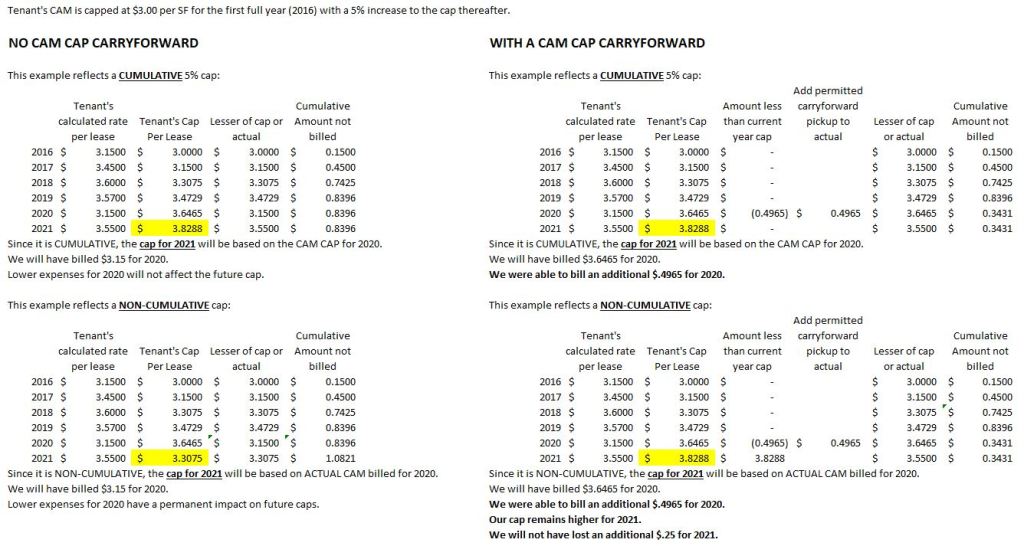Deductions and exclusions from reported gross sales
October 19, 2020
ICSC published a brief summary of a handful of timely legal issues discussed during its 50th U.S. Law Conference. Among the topics were a few percentage rent concerns. They are all relevant in the current environment and worthy of addressing the “whys” of the topics and expanding on them a bit.
Before hitting those issues, I want to make a quick distinction. There are two general categories that negotiated changes fall into for the definition of Gross Sales – Exclusions and Deductions. Both reduce Gross Sales, but it is important to see the difference. Exclusions are types of revenues that do not get included in reported Gross Sales. If a revenue is generated, it must be included unless an Exclusion is negotiated. (For exclusions, think along the lines of alteration income for a clothing store, or lottery tickets sales for a supermarket or liquor store. These would be expense categories that might be negotiated as exclusions from Gross Sales.) Deductions, however, are more typically expenses that can be deducted from reported Gross Sales. (For deductions, think along the lines of credit card charges. This would be a retailer’s expense that might be negotiated as a deduction.) This might seem like semantics, but it is important to understand the distinction. Why? Because there are no Exclusions or Deductions from reported Gross Sales unless they have been specifically negotiated.
Now, finally! On to the issues raised by ICSC:
Pop-ups within stores raise questions about percentage rent leases, and (Ruth) Schoenmeyer advised landlords to make sure lease language defines the sales on which percentage rent is based to include anything sold within the leaseholder’s space. That covers products sold by a pop-up retailer within another retailer’s store.
“Gross Sales” are typically defined as sales made “in, at, on, or from the Demised Premises.” Therefore, based upon this most common starting definition of Gross Sales, the Pop-ups’ sales are required to be included in reported Gross Sales. Required – doesn’t mean they are. So, unless the tenant has negotiated the exclusion of sales from pop-up stores (or concessions), these sales must be included by the tenant when reporting its Gross Sales. (We are sticking to sales for this blog, but, hopefully, you are thinking of a few other issues reading this. Think along the lines of perhaps a Sephora in a JC Penney, or a Starbucks in a Barnes & Noble. Are they permitted to have a pop-up in the store? How might that affect existing exclusives in the center? How might that affect my ability to lease to another cosmetics store or coffee shop in the center?) Often, if the landlord concedes to the tenant’s request to exclude the sales from permitted concessions within the premises, the tenant will be required to include the rents received from the concessionaire/pop-up/subtenant. It will often just be a small fraction of the sales themselves, often keeping a tenant from achieving a breakpoint.
Retailers want to minimize gross sales as accounted by the landlord. However, landlords nowadays want to know if the property in question was “touched” at any point during the transaction. Did the consumer pay for the item at the store or pick it up there? Perhaps the item was stored there if the retailer is fulfilling online purchases from the store.
Back to that “in, at, on or from the Demised Premises,” if the premises is involved in any way, the sales are required to be included in gross sales unless an exclusion is negotiated. Last week, my wife went to the local running store for a new pair of Hokas. She made the purchase in the premises, and must be reported. If the shoes were not available and they shipped them to her, the sale was made at the premises and must be reported. In June, I walked a great property in North Carolina with a cupcake store. They had beautiful wedding cakes on display. If the cake was ordered elsewhere but baked on the premises, it must be included in gross sales. And, if I go on to Amazon to order from Whole Foods and pick up my order two hours later, that sale was made from the premises and must be included in gross sales. All of these are examples of sales made in, at, on or from the demised premises that must be included in reported gross sales unless an exclusion has been negotiated.
Ulmer & Berne managing partner Scott Kadish said negotiations should occur around deducting payments to third-party delivery services from restaurant sales for lease purposes.
“Deducting” in the paragraph above says enough. If you place a $20 restaurant order using a delivery service, the sale made at the restaurant is $20. The restaurant then pays a percentage of the order, say 20%, to the delivery service. The sale is $20, the expense is $4. The restaurant tenant must report $20. If it has negotiated a deduction for third party delivery charges, it may deduct $4, ultimately reporting Gross Sales of $16. This is comparable to a tenant negotiating a deduction for credit card fees. A $20 sale made by credit card is $20. The 3% fee paid to a credit card company is an expense of the retailer that cannot be deducted from reported gross sales unless a tenant has negotiated a deduction of credit card fees. (Again, just a brief distinction between exclusions and deductions – retailers often negotiate the exclusion of employee sales (often with a landlord-imposed limit) because the retailer gives a substantial discount to employees. Theaters will often negotiate the exclusion of certain box-office receipts when the royalty on a movie exceeds 35-40%.)
Schoenmeyer also noted that lease drafters should consider the impact on gross sales of buy-online-return-in-store programs.
There are certain “givens” related to sales that do not have to be negotiated (yet some retailers will still add them to their negotiated deductions and exclusions just to play it safe). Sales taxes collected by a retailer on behalf of a state or municipality are not sales. You buy a $10.00 item and you pay $10.70 with sales tax. The sale is $10.00, not $10.70. And, returns of purchases made automatically reduce sales. That same $10 purchase returned reduces sales by $10, for a net $0. But, as Ruth Schoenmeyer pointed out, landlords really need to consider the impact of Buy Online Return in Store. For most retailers, a $10 purchase online is not credited to a store, yet that same purchase, returned to a store will be treated as a return, reducing sales when the original sale was never included! The typical “standard” lease definition of gross sales does not sufficiently address the reality of online sales returned in store. An adequate way to address this prospectively might be to state in the standard lease form that “only returns for sales previously included in reported gross sales may be used to reduce sales.”
In any event, these are just a few of the hundreds of exclusions, deductions and other considerations keeping sales audit firms busy. While many landlords reserve sales audits for tenants and periods where sales approach 90% of a tenant’s breakpoint (because there would be a greater likelihood of additional percentage rent due), the current effects of coronavirus actually create a more pressing need for sales audits (as some tenants have been temporarily converted to a percentage in lieu of minimum rent (and every adjustment results in a percentage rent change) or tenants request rent relief).
If you are puzzled by the value of a specific exclusion or deduction that you have seen in any of your leases, comment below and we’ll be happy to address it here.




